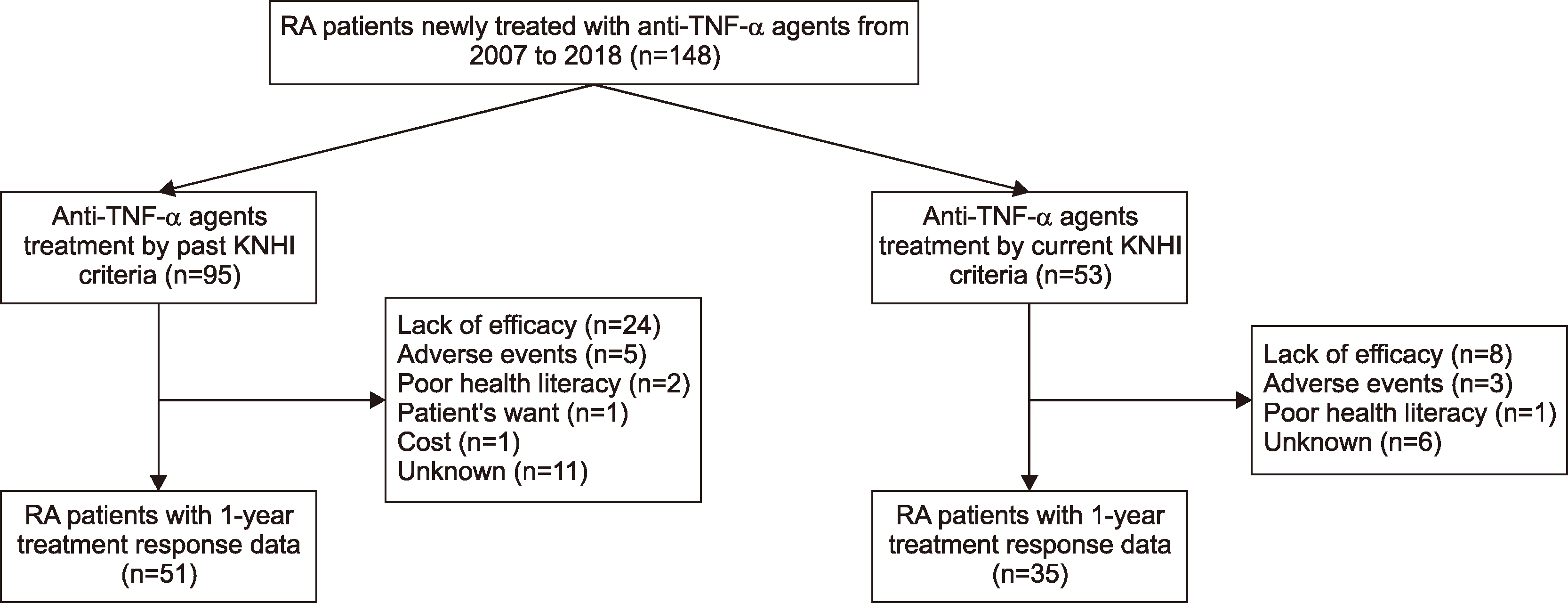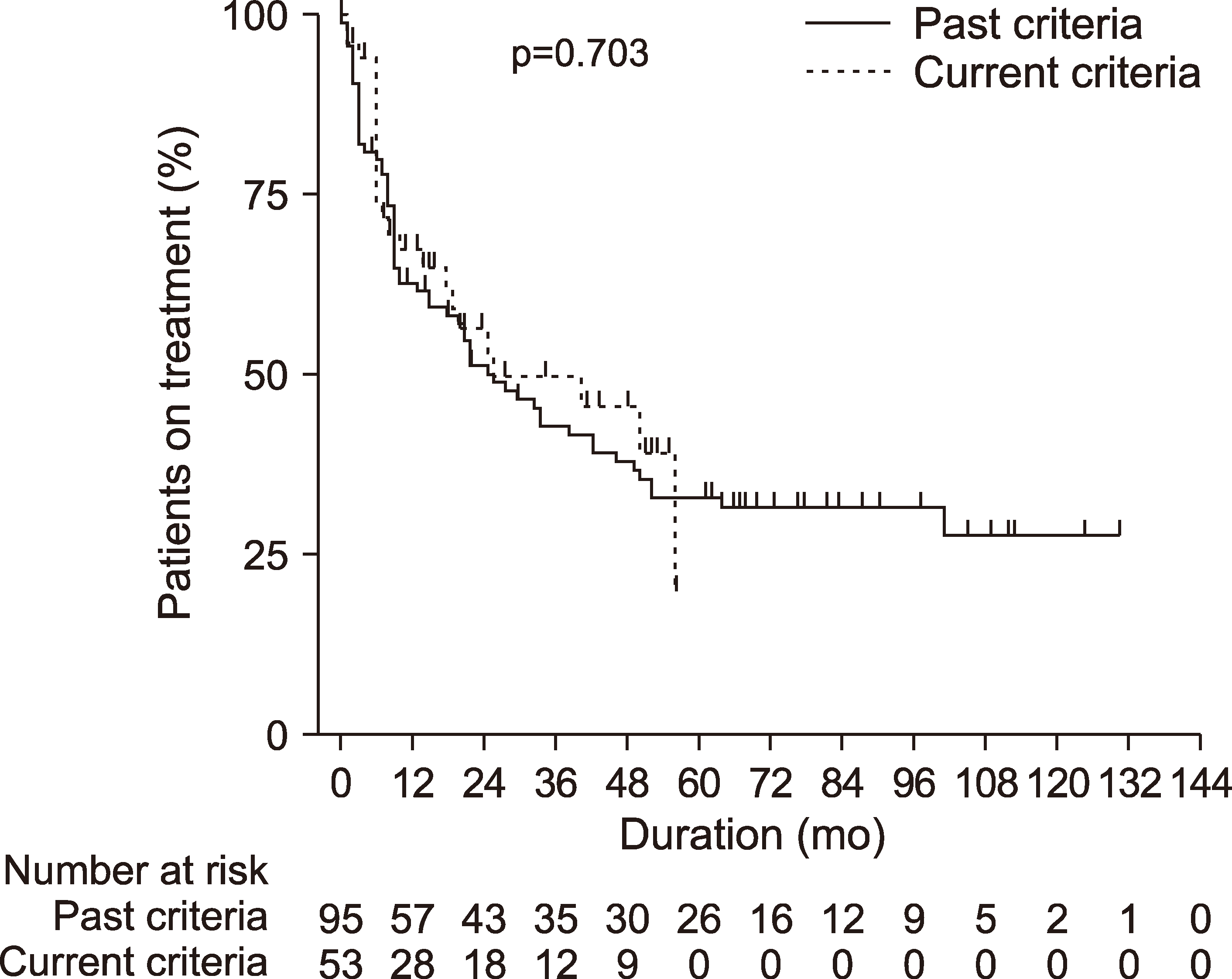1. Caporali R, Crepaldi G, Codullo V, Benaglio F, Monti S, Todoerti M, et al. 2018; 20 years of experience with tumour necrosis factor inhibitors: what have we learned? Rheumatology (Oxford). 57(57 Suppl 7):vii5–10. DOI:
10.1093/rheumatology/key059. PMID:
30289535.

2. Singh JA, Saag KG, Bridges SL Jr, Akl EA, Bannuru RR, Sullivan MC, et al. 2016; 2015 American College of Rheumatology guideline for the treatment of rheumatoid arthritis. Arthritis Rheumatol. 68:1–26. DOI:
10.1002/art.39480. PMID:
26545940.

3. Smolen JS, Landewé R, Bijlsma J, Burmester G, Chatzidionysiou K, Dougados M, et al. 2017; EULAR recommendations for the management of rheumatoid arthritis with synthetic and biological disease-modifying antirheumatic drugs: 2016 update. Ann Rheum Dis. 76:960–77. DOI:
10.1136/annrheumdis-2016-210715. PMID:
28264816.
4. Souliotis K, Papageorgiou M, Politi A, Ioakeimidis D, Sidiropoulos P. 2014; Barriers to accessing biologic treatment for rheumatoid arthritis in Greece: the unseen impact of the fiscal crisis--the Health Outcomes Patient Environment (HOPE) study. Rheumatol Int. 34:25–33. DOI:
10.1007/s00296-013-2866-1. PMID:
24057144.

5. Desai RJ, Rao JK, Hansen RA, Fang G, Maciejewski ML, Farley JF. 2014; Predictors of treatment initiation with tumor necrosis factor-
α inhibitors in patients with rheumatoid arthritis. J Manag Care Spec Pharm. 20:1110–20. DOI:
10.18553/jmcp.2014.20.11.1110. PMID:
25351972.
6. Son KM, Jung DM, Kim YB, Han JS, Seo YI, Jung YO, et al. 2012; Comparison Korean National Health Insurance Reimbursement and other guidelines for TNF-
α blocker in rheumatoid arthritis. J Rheum Dis. 19:334–40. DOI:
10.4078/jrd.2012.19.6.334.
7. Won S, Sung YK, Cho SK, Choi CB, Koh EM, Kim SK, et al. 2014; Prediction for TNF inhibitor users in RA patients according to reimbursement criteria based on DAS28. J Rheum Dis. 21:64–73. DOI:
10.4078/jrd.2014.21.2.64.

8. Lee YJ. 2014; Usage of Anti-TNF
α agents in patients with rheumatoid arthritis and Korean National Health Insurance reimbursement criteria. J Rheum Dis. 21:107–9. DOI:
10.4078/jrd.2014.21.3.107.
9. Lee JH, Cho SK, Choi CB, Sung YK, Bae SC. 2011; Impact of change in reimbursement guideline of rheumatoid arthritis on the short term persistence of Tumor Necrosis Factor (TNF) blockers. J Rheum Dis. 18:283–7. DOI:
10.4078/jrd.2011.18.4.283.

10. Arnett FC, Edworthy SM, Bloch DA, McShane DJ, Fries JF, Cooper NS, et al. 1988; The American Rheumatism Association 1987 revised criteria for the classification of rheumatoid arthritis. Arthritis Rheum. 31:315–24. DOI:
10.1002/art.1780310302. PMID:
3358796.

11. Aletaha D, Neogi T, Silman AJ, Funovits J, Felson DT, Bingham CO 3rd, et al. 2010; 2010 Rheumatoid arthritis classification criteria: an American College of Rheumatology/European League Against Rheumatism collaborative initiative. Arthritis Rheum. 62:2569–81. DOI:
10.1002/art.27584. PMID:
20872595.
12. Prevoo ML, van 't Hof MA, Kuper HH, van Leeuwen MA, van de Putte LB, van Riel PL. 1995; Modified disease activity scores that include twenty-eight-joint counts. Development and validation in a prospective longitudinal study of patients with rheumatoid arthritis. Arthritis Rheum. 38:44–8. DOI:
10.1002/art.1780380107. PMID:
7818570.

13. van Riel PL. 2014; The development of the disease activity score (DAS) and the disease activity score using 28 joint counts (DAS28). Clin Exp Rheumatol. 32(5 Suppl 85):S-65–74.
14. van Gestel AM, Prevoo ML, van't Hof MA, van Rijswijk MH, van de Putte LB, van Riel PL. 1996; Development and validation of the European League Against Rheumatism response criteria for rheumatoid arthritis. Comparison with the preliminary American College of Rheumatology and the World Health Organization/International League Against Rheumatism Criteria. Arthritis Rheum. 39:34–40. DOI:
10.1002/art.1780390105. PMID:
8546736.

15. Lee HN, Kim YK, Kim GT, Ahn E, So MW, Sohn DH, et al. 2019; Neutrophil-to-lymphocyte and platelet-to-lymphocyte ratio as predictors of 12-week treatment response and drug persistence of anti-tumor necrosis factor-
α agents in patients with rheumatoid arthritis: a retrospective chart review analysis. Rheumatol Int. 39:859–68. DOI:
10.1007/s00296-019-04276-x. PMID:
30874873.
16. Park JH, Park EK, Koo DW, Lee S, Lee SH, Kim GT, et al. 2017; Compliance and persistence with oral bisphosphonates for the treatment of osteoporosis in female patients with rheumatoid arthritis. BMC Musculoskelet Disord. 18:152. DOI:
10.1186/s12891-017-1514-4. PMID:
28399834. PMCID:
PMC5387221.

17. Lee SG, Park EK, Park JH, Kweon SM, Kim YK, Kim GT. 2018; Compliance and persistence with hydroxychloroquine in South Korean patients with systemic lupus erythematosus. Lupus. 27:753–61. DOI:
10.1177/0961203317742712. PMID:
29157178.

18. Orlewska E, Ancuta I, Anic B, Codrenau C, Damjanov N, Djukic P, et al. 2011; Access to biologic treatment for rheumatoid arthritis in Central and Eastern European (CEE) countries. Med Sci Monit. 17:SR1–13. DOI:
10.12659/MSM.881697. PMID:
21455121. PMCID:
PMC3539513.

19. Hoebert JM, Mantel-Teeuwisse AK, van Dijk L, Bijlsma JW, Leufkens HG. 2012; Do rheumatoid arthritis patients have equal access to treatment with new medicines?: tumour necrosis factor-alpha inhibitors use in four European countries. Health Policy. 104:76–83. DOI:
10.1016/j.healthpol.2011.10.011. PMID:
22079753.

20. Putrik P, Ramiro S, Kvien TK, Sokka T, Uhlig T, Boonen A. 2014; Variations in criteria regulating treatment with reimbursed biologic DMARDs across European countries. Are differences related to country's wealth? Ann Rheum Dis. 73:2010–21. DOI:
10.1136/annrheumdis-2013-203819. PMID:
23940213.

21. Putrik P, Ramiro S, Kvien TK, Sokka T, Pavlova M, Uhlig T, et al. 2014; Inequities in access to biologic and synthetic DMARDs across 46 European countries. Ann Rheum Dis. 73:198–206. DOI:
10.1136/annrheumdis-2012-202603. PMID:
23467636.

22. Kaló Z, Vokó Z, Östör A, Clifton-Brown E, Vasilescu R, Battersby A, et al. 2017; Patient access to reimbursed biological disease-modifying antirheumatic drugs in the European region. J Mark Access Health Policy. 5:1345580. DOI:
10.1080/20016689.2017.1345580. PMID:
28740623. PMCID:
PMC5508389.

23. Bergstra SA, Branco JC, Vega-Morales D, Salomon-Escoto K, Govind N, Allaart CF, et al. 2018; Inequity in access to bDMARD care and how it influences disease outcomes across countries worldwide: results from the METEOR-registry. Ann Rheum Dis. 77:1413–20. DOI:
10.1136/annrheumdis-2018-213289. PMID:
29980576.

24. Hur JW, Choe JY, Kim DW, Kim HA, Kim SH, Kim WU, et al. 2015; Rheumatoid arthritis patients fulfilling Korean National Health Insurance reimbursement guidelines for anti-tumor necrosis factor-
α treatment and comparison to other guidelines. Rheumatol Int. 35:1817–23. DOI:
10.1007/s00296-015-3353-7. PMID:
26342296.
25. Smolen JS, Breedveld FC, Burmester GR, Bykerk V, Dougados M, Emery P, et al. 2016; Treating rheumatoid arthritis to target: 2014 update of the recommendations of an international task force. Ann Rheum Dis. 75:3–15. DOI:
10.1136/annrheumdis-2015-207524. PMID:
25969430. PMCID:
PMC4717393.
26. Neovius M, Arkema EV, Olsson H, Eriksson JK, Kristensen LE, Simard JF, et al. 2015; Drug survival on TNF inhibitors in patients with rheumatoid arthritis comparison of adalimumab, etanercept and infliximab. Ann Rheum Dis. 74:354–60. DOI:
10.1136/annrheumdis-2013-204128. PMID:
24285495. PMCID:
PMC4316855.

27. Park EY, Lee SG, Park EK, Koo DW, Park JH, Kim GT, et al. 2018; Drug survival and the associated predictors in South Korean patients with rheumatoid arthritis receiving tacrolimus. Korean J Intern Med. 33:193–202. DOI:
10.3904/kjim.2015.385. PMID:
27048254. PMCID:
PMC5768536.
28. Park JA, Lee MY, Nam JH, Shin JY, Wood R, Holbrook T, et al. 2020; Real-world treatment persistence of non-tumor necrosis factor inhibitors versus tumor necrosis factor inhibitors among patients with rheumatoid arthritis in South Korea. Curr Med Res Opin. 36:343–51. DOI:
10.1080/03007995.2019.1688271. PMID:
31670976.

29. Kang JH, Park DJ, Lee JW, Lee KE, Wen L, Kim TJ, et al. 2014; Drug survival rates of tumor necrosis factor inhibitors in patients with rheumatoid arthritis and ankylosing spondylitis. J Korean Med Sci. 29:1205–11. DOI:
10.3346/jkms.2014.29.9.1205. PMID:
25246737. PMCID:
PMC4168172.

30. Favalli EG, Pregnolato F, Biggioggero M, Becciolini A, Penatti AE, Marchesoni A, et al. 2016; Twelve-year retention rate of first-line tumor necrosis factor inhibitors in rheumatoid arthritis: real-life data from a local registry. Arthritis Care Res (Hoboken). 68:432–9. DOI:
10.1002/acr.22788. PMID:
26556048.

31. Malaviya AP, Ostör AJ. 2012; Drug adherence to biologic DMARDS with a special emphasis on the benefits of subcutaneous abatacept. Patient Prefer Adherence. 6:589–96. DOI:
10.2147/PPA.S23786. PMID:
22936845. PMCID:
PMC3429155.






 PDF
PDF Citation
Citation Print
Print



 XML Download
XML Download